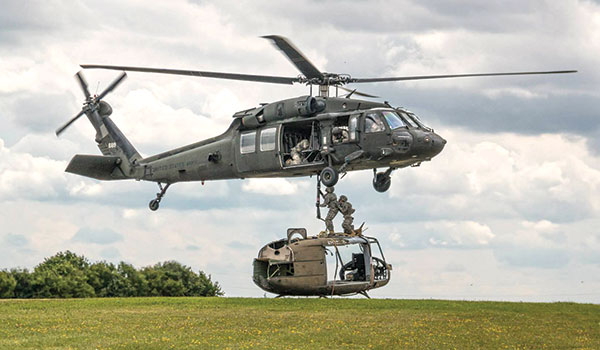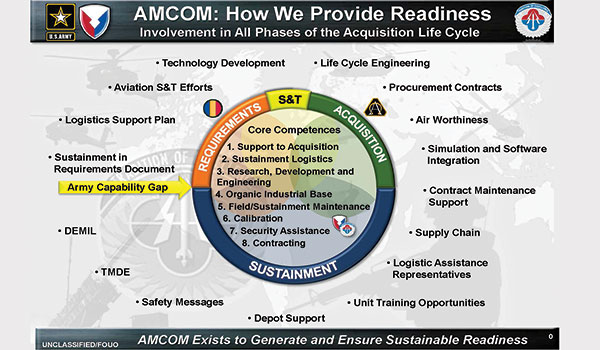
Aviation Maintenance / By Mr. William P. Marriott and Mr. David L. Ward: In February 2016, in an effort to better enable unity of command, and provide improved support for our Warfighters, the Army Materiel Command (AMC) directed a major reorganization initiative. Published as OPORDER 16-189, AMC aligned the research, development, and engineering centers (RDECs) and contracting centers under the operational control (OPCON) of their associated life cycle management commands (AMCOM, CECOM and TACOM). For AMCOM, this meant that the Aviation and Missile Research, Development, and Engineering Center (AMRDEC) and the Army Contracting Command – Redstone Arsenal (ACC-R) fell under AMCOM.

Aviation Soldiers conducting sling load training using the unit maintenance aerial recovery kit (UMARK).
Despite the challenges brought on from 15 years of high tempo real world operations, the Army Aviation Enterprise has enjoyed immense success, in large part due to the Branch’s synchronized approach to solving problems. One can argue that this was primarily due to the strong relationships and trust between senior leaders, enabled by internally developed governing processes such as the Six Pack. Using this same template, AMCOM took the opportunity provided by the OPORDER’s specified command and control relationship to push collaboration even further. Internally named OPERATION UNIFIED ACTION, the order lays out a series of principles and processes which will better enable the Army Aviation Enterprise to prioritize, synchronize, and integrate our capabilities in order to meet the Branch’s and Army’s priorities.
Upon receiving the AMC OPORD, AMCOM conducted its own mission analysis, and as part of that process, working with AMCOM, AMRDEC, and ACC-R senior leaders, rewrote our Mission and Vision statements. The new statements reflect improved capabilities and a renewed focus on readiness, our future force and taking care of our Soldier, Department of the Army Civilians, and their families.
The new AMCOM Mission: AMCOM develops and delivers responsive aviation, missile and calibration materiel readiness to the United States Army in order to optimize joint Warfighter capabilities at the point of need.
The new AMCOM Vision: Mission First, People Always, enabling synchronized aviation, missile and calibration materiel enterprises providing unmatched capability for the Army and the Nation.

Several key words should be noted in the mission statement. The phrase “develops and delivers” was specifically chosen to be inclusive of the science and technology work and contracting work that AMRDEC and ACC-R perform respectively. The word “responsive” reflects the importance of staying in touch with Soldiers and AMCOM Logistic Assistance Representatives (LARs) in the field and providing solutions to them rapidly wherever and whenever needed. Many actions have long lead times – it is AMCOM’s goal to be proactive to have enough situational awareness to anticipate and be prepared to deliver “materiel readiness.” Finally, “at the point of need” is specifically included as recognition of the fact that we ultimately support our combat aviation brigades, air defense artillery brigades, and other formations that provide combatant commanders with warfighting capabilities.
While the end-state is to provide materiel readiness at the point of need, it takes the entire AMCOM team in coordination with Program Executive Office (PEO) Aviation and other stakeholders over the entire lifecycle of a weapon system to ensure success. The power of UNIFIED ACTION is already being felt in theater as we use every aspect of our core competencies, from supporting the rapid acquisition and fielding of weapons to meet commanders’ urgent materiel needs, to ensuring airworthiness issues are thoroughly researched, addressed and resolved, to ensuring appropriate priority is focused on sustaining the systems our troops will need to fight with “tonight”, wherever they might be.
Ultimately to be able to synchronize multiple efforts and priorities across the aviation and missile Enterprise is the goal of UNIFIED ACTION. Figure 1 highlights where and how the Enterprise achieves materiel readiness throughout multiple phases of the acquisition lifecycle.
For any new system, the process starts with getting the requirements right. This is clearly a Training and Doctrine Command (TRADOC) function, but AMCOM is assisting the United States Army Aviation Center of Excellence (USAACE) in ensuring that sustainment and reliability requirements are appropriately developed and included in the acquisition requirement process. It is vital that sustainment, which is typically 70% of the lifecycle cost of a system, is considered early in the acquisition process so we don’t develop systems that are unaffordable to operate due to high maintenance costs or present an undue burden on our Soldier maintainers. To facilitate this process, in FY16, AMCOM embedded logistical experts with USAACE at Fort Rucker to work with the TRADOC Capabilities Managers in support of the Branch.
After a weapon system is fielded and transitions into sustainment, AMCOM assumes a leading role in ensuring the materiel readiness of the system. The AMCOM Logistics Center provides spare parts, LARs, technical publications, Quality Deficiency Reports processing, among various other support functions. UNIFIED ACTION is critical during the sustainment phase, as AMRDEC continues to provide engineering services and ACC-R continues to provide contracting support. A recent example of UNIFIED ACTION’s positive impact is the design, production and fielding of a new AH-64 staking tool in conjunction with the Program Manager within 60 days.
Synchronizing Future Capabilities
For the first time in more than a decade, the AMCOM team, under UNIFIED ACTION, has been able to see and synchronize future aviation capabilities throughout the entire acquisition process. There is no doubt that AMRDEC has always done an exceptional job in helping develop the science and technology needed for future systems. For example, they have led the Department of Defense’s efforts on Future Vertical Lift, the Improved Turbine Engine Program, and operating in a degraded visual environment. Today the Aviation Enterprise is better positioned to ensure our limited resources are being applied in accordance with the Army’s priorities.
pecifically, the AMCOM CG plays a pivotal role in the approval process of AMRDEC’s Program Objective Memorandum submission, ACC-R contract priorities, Aviation and Missile system Materiel Release requests, weapon system Life Cycle Sustainment Plans and airworthiness decisions. Given the breadth and scope of AMCOM’s mission, the visibility and authority provided by UNIFIED ACTION and the relationships with the Branch and PEOs ensure transparency, communication prioritization and resourcing of Aviation capabilities.
As we move forward toward an uncertain future, it will be more important than ever for AMCOM to operationalize our team to enhance contributions to the Warfighter. The Aviation Enterprise has always been strong, and UNIFIED ACTION across AMC organizations will further strengthen the Enterprise and improve our ability to prioritize and synchronize efforts to enable readiness. Through UNIFIED ACTION, the AMCOM team will be positioned to improve responsiveness to the Warfighter, no matter how austere or challenging the conditions, with on time delivery of the right equipment and services at the point of need. We owe our Soldiers nothing less.
Mr. William P. Marriott is the deputy to the commander and Mr. David L. Ward is a strategist in the G-5, Strategy Concepts and Plans, of the U.S. Army Aviation and Missile Life Cycle Management Command (AMCOM) at Redstone Arsenal, AL.
























